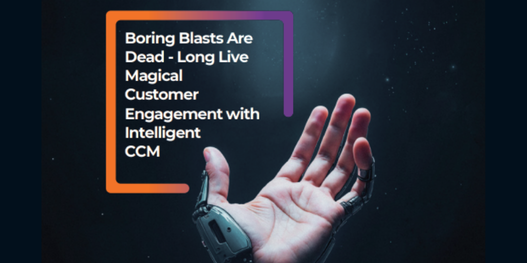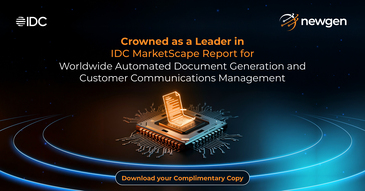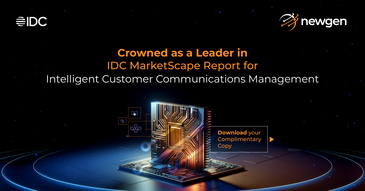Introduction: Customer Communication Management (CCM)
Customer experience (CX) is no longer defined by a few key moments; it’s shaped by every interaction, every alert, statement, policy update, and service message. Yet, enterprises often struggle to maintain consistency as they grow. The challenge isn’t creativity; it’s scalability.
This is where Customer Communication Management (CCM) becomes the silent force behind successful customer experience strategies. Modern CCM platforms, powered by AI, automation, agentic intelligence, and low-code architecture, enable enterprises to communicate at scale, without losing personalization, brand guidelines, compliance, or empathy.
Why Does Scalability Define Modern CX?
Today’s customers expect seamless, personalized communication across every channel, email, WhatsApp, chatbots, self-service portals, and beyond. According to McKinsey, two-thirds of millennials expect real-time responses, and 75 % of customers expect brand consistency across touchpoints.
For organizations handling millions of transactions daily, delivering that level of connectedness isn’t a marketing challenge; it’s an architectural one. Scalable CX means being able to grow, adapt, and respond instantly, without adding complexity or losing control.
What Makes Modern CCM the Core of Scalable CX?
Modern CCM systems do more than send messages. They orchestrate contextual, compliant, and omnichannel communications that align with customer journeys.
Unlike legacy systems, intelligent CCM platforms combine content services, process automation, and AI-driven personalization, ensuring every message is timely, accurate, and relevant.
Core Capabilities That Enable Scale
1. AI-powered Content Authoring and Localization
- Auto-generate multilingual templates and messages with built-in generative AI.
- Reduce authoring time significantly, ensuring faster go-to-market for campaigns.
2. Journey-based Orchestration
- Design communication flows that mirror real customer journeys, from onboarding to servicing and renewal.
- Automatically adapt messages based on customer actions or data triggers.
3. Omnichannel Delivery
- Integrate digital and print channels into a unified framework.
- Maintain context across chatbots, portals, and contact-center interactions.
4. Compliance and Governance
- Centralize brand, tone, and regulatory rules.
- Enforce version control and audit trails without manual reviews.
5. Analytics and Optimization
- Measure engagement, turnaround time, and communication impact.
- Use insights to fine-tune templates, timing, and delivery frequency.
6. Multi-branding Capabilities
- Track consistency across templates with centralized style management
- Update once and it reflects everywhere without disrupting brand integrity
- Apply dynamic branding logic to personalize at scale
- Measure engagement, turnaround time, and communication impact
- Use insights to fine-tune templates, timing, and delivery frequency
How Does CCM Turn Fragmented Journeys into Cohesive Experiences?
Most enterprises have silos, marketing sends promotions, operations send notices, and support teams handle service alerts. Customers, however, experience all of it as one brand.
A unified CCM platform bridges these silos, connecting data and design layers across systems like CRM, ECM, and BPM.
For instance:
- In banking, CCM converts static statements into interactive dashboards showing spending patterns and saving tips.
- In insurance, policy updates, renewal notices, and claims status alerts are personalized and simplified.
- In telecom, smart billing and outage notifications proactively inform and assist customers.
- In healthcare, denial letters, provider updates, and patient outreach are automated and compliant.
These aren’t isolated use cases, they demonstrate how scalable CX depends on an integrated CCM core.
Newgen Recognized as a ‘Leader’ in the IDC MarketScape for Automated Document Generation and Customer Communication Management
What Are the Business Benefits of a Scalable CCM Approach?
- Faster Time-to-market
Centralized templates and low-code authoring enable faster rollout of regulatory or product updates, reducing turnaround times, significantly.
- Improved Customer Engagement
AI-driven personalization delivers messages that resonate. BCG estimates that personalization could shift $2 trillion in annual revenue to companies that master context-aware communication.
- Lower Operational Costs
Automation eliminates redundant authoring and manual compliance checks. Teams can manage thousands of templates without expanding headcount.
- Greater Brand Consistency and Compliance
One source of truth for content ensures brand voice and regulatory text stay aligned globally.
- Real-time Insights
Integrated analytics reveal what works and what doesn’t, enabling a self-learning communication ecosystem.
How Do You Build a Scalable CX Strategy with CCM?
A scalable CX model requires both strategy and structure. Here’s a practical roadmap:
1. Assess Communication Maturity
- Identify gaps in personalization, governance, and integration.
- Map customer journeys to current communication assets.
2. Consolidate Templates and Content
- Create modular libraries of approved content blocks.
- Introduce rule-based personalization to scale messaging safely.
3. Integrate Systems and Data Sources
- Connect CCM with CRM, BPM, and data lakes for unified context.
- Enable real-time event triggers for responsive communications.
4. Empower Business Users
- Use low-code tools so non-technical teams can modify templates and workflows.
- Free IT to focus on architecture and innovation.
5. Establish Governance and Feedback Loops
- Build communication councils spanning CX, legal, and IT.
- Review performance data and continuously optimize.
Which Industries Benefit Most from Scalable CCM?
- Banking and Financial Services
Transform statements into financial-wellness dashboards; automate loan notifications and fraud alerts. - Insurance
Simplify policy renewals, automate claims updates, and deliver personalized coverage summaries—cutting customer effort. - Telecom
Replace static bills with interactive usage alerts, recommendations, and loyalty offers. - Healthcare
Personalize member communication and automate appeals, compliance, and provider contracting workflows.
Across sectors, the pattern is the same: clarity + consistency = trust, and trust fuels growth.
Newgen Recognized as a ‘Leader’ in the IDC MarketScape Report for Intelligent Customer Communications Management
What Features Should Executives Look for in a CCM Platform?
When evaluating CCM solutions, focus on features that align with both business agility and customer experience goals:
| Feature | Why It Matters |
|---|---|
| Unified authoring and design environment | Ensures brand consistency and collaboration between business and IT. |
| Low-code configuration | Enables quick iteration without long development cycles. |
| GenAI-powered content generation | Speeds up authoring and localization with contextual accuracy, with the template designer capabilities. |
| Omnichannel orchestration | Keeps messaging consistent across channels and devices. |
| Advanced analytics | Tracks engagement, delivery rates, and CX outcomes. |
| Compliance framework | Automates legal approvals and audit readiness. |
How Does Newgen’s Intelligent CCM Enable Scalable CX?
According to IDC, Newgen’s platform is recognized as one of the most robust and scalable solutions for managing complex communication networks and AI-powered journeys.
Key Differentiators of NewgenONE AI-first Omnichannel CCM Platform
- AI-first Content and Localization
Automatically generate and personalize communications with multilingual support and dynamic components. - Smart Content Assembly and Personalization
Maintain a centralized library of approved content snippets for dynamic, rule-based assembly, tailoring messages based on user behavior. - Conversational AI and Continuous Learning
Integrate with NewgenONE Marvin, enabling two-way, interactive conversations and intelligent routing of responses. - Rich Media and Dynamic Journeys
Embed personalized videos, adaptive layouts, and conditional workflows for higher engagement. - API-first, Low-code Architecture
Connect seamlessly with CRM, ERP, and legacy systems while empowering non-technical users to modify templates quickly. - Analytics and Optimization
Tie communications directly to ROI, proving which message variant drives better response or satisfaction.
CCM – Industry Use Cases
- Banking: Personalized statements, proactive loan eligibility insights, and instant fraud resolution.
- Insurance: Simplified claims updates, coverage highlights, and guided renewals.
- Telecom: Real-time usage alerts, outage notifications, and dynamic offers.
- Healthcare: Automated denial letters, provider communications, and personalized patient engagement.
NewgenONE Intelligent CCM enables enterprises to transform static communications into adaptive, insight-driven dialogues that evolve with every customer interaction.
FAQs
1. What is Customer Communication Management?
Customer Communication Management, also known as omnichannel customer engagement, refers to a convergent set of information technology solutions that enable organizations to manage every aspect of customer communication. CCM provides a centralized platform that connects an organization’s enterprise and core applications, web modules, portals, customer relationship management systems, etc. and automates the delivery of communications across multiple engagement channels, including email, print, SMS, WhatsApp, and other social media platforms.
Additionally, CCM helps organizations to personalize communications, based on the customer’s profile, interests, and behavioral patterns, and to share targeted communications on their preferred channels. Armed with various functionalities, including modern designer, secure distribution, tracking and monitoring, user-friendly templates, Newgen’s omnichannel customer engagement software, enables business leaders to enhance customer experience with personalized and consistent communications across channels.
2. What to Look for in an Ideal Customer Communication Management Software?
Listed here are 10 key considerations for selecting an ideal customer communication management software:
- Flexible designing and authoring designer
- Extensive template management capabilities
- Web-based content repository
- Automated document generation
- Faster letter and contract generation
- Multi-channel distribution and tracking
- Diverse integration capabilities
- Strong user management and extensive audit logs
- Robust integration with business applications, core systems, portals, etc.
- Cloud deployments, enabling faster time-to-market
You might be interested in


09 Jan, 2025
Analyst Report: Newgen Recognized as a ‘Leader’ in the IDC MarketScape for Automated Document Generation and Customer Communication Management

07 Jan, 2025
Analyst Report: Newgen Recognized as a ‘Leader’ in IDC MarketScape Report for Intelligent CCM

